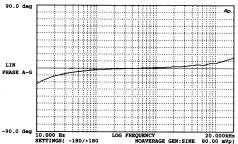
Acoustic Monster (A.M.)
DIY and Custom Built High-End Audio Equipment
Designed and Developed in Singapore
Technical Review and Specifications of Audio Note 211 Ongako Monoblock Parallel Single Ended Tube Power Amplifier.
RESULTS & DISCUSSION OF 211/845 MPAs
The
211/845 MPAs measurement results will be discussed in this section.
With a dummy load (a huge power resistor) connected to the amplifierís
output, we drive the power amplifier input with a reference voltage just below
clipping across the output terminals. The
output power is plotted against frequency from 10 Hz to 20 KHz.
This
measurement allows us to look at a power amplifierís output capability and is
known as the power-bandwidth test. We
are looking for widest bandwidth over which the amplifier can maintain full
output power. The measured result shown in figure 10 is the power-bandwidth
measurement. The frequency
response is ranged from 10 Hz to 45 KHz, taken
at - 3dB region.

Figure 10. 211/845 MPAs Frequency Response
The
second measurement taken is the THD+N against output level of 1 Watt into 8
ohms. The result is shown in figure
11. The harmonic distortion
is fairly low at the important frequency range of 100Hz to 10KHz.

Figure 11. 211/845 MPAs Harmonic Distortion
As
you can see from the THD+N measurement in figure 11, the result measured is not
as good as compared to transistorís THD+N measurement.
However, bear in mind that valve amplifier in clipping produces primarily
second- and third-harmonic distortion, which is fairly benign sonically.
A transistor amplifier when driven into clipping immediately produces a
whole series of very objectionable upper-order odd harmonics (fifth, seventh,
ninth). In fact, 10%
second-harmonic distortion is less annoying than 0.5% seventh-harmonic
distortion.

Figure 12. 211/845 MPAs Phase Response
Lastly,
phase measurement is taken for the 211/845 MPAs.
In figure 12, it shows that the amplifier does not have any severe phase
angle swings. The phase angle
swings at +/- 20 degree variation at both the
extreme
ends of the audio frequency range. The
amplifier stays resistive at the frequency range of 60 Hz to 3 KHz.
The result obtained is very healthy for music reproduction.
CONCLUSION
Considering
the THD+N measurements, we
can see that Valve amplifiers do not measure well on paper.
However, at the end of the day, what matters most is the music and we
know that valves sound more musical than our solid-state counterparts.
C O P Y R I G H T © 1 9 9 8 -- 2 0 0 4 Acoustic Monster